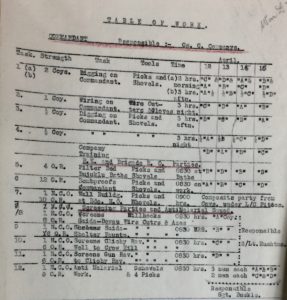Friday April 12th, 1918
Dismounted Quarter Guard and no further duties for the day. Had a good tea – custard and pineapple.
Table of Works

A new Table of Works has been issued for the Battalion to cover 12th to 15th April. According to its schedule, half of B Company should have been digging trenches on the Commandant this afternoon. Lucky for Frank, it seems to be the ‘other half’ because, after dismounting Quarter Guard, he enjoys a day of leisure. The icing on the cake? For some reason, pineapple and custard seems to have made Frank a ‘good tea’.
In addition to digging and wiring, there are other tasks to be undertaken over the next four days. Some of these will be under the supervision of the Royal Engineers.
Four other ranks (OR) will be working each day on the filter beds at Frank’s beloved Bujuklu Baths. Two larger parties will be creating ‘bombproof on Commandant’ and ‘building walls at Brigade HQ’.
Yesterday’s Battalion Diary mentioned the additional responsibilities being taken on regarding screening. As a result there will be four parties, under 2Lt Rushton, working on four different areas of the expanded line. Ten men will also be working on ‘anti-malarial work’.
Signallers

As with many other disciplines, communications was transformed in WWI. The mobile warfare of 1914 and 1918 and the static warfare of the years between created distinct communication strategies. One particular feature of static warfare was the use of hardwired telephone and telegraph services. While wires were ‘deep buried’ when in the range of artillery fire, this was not always possible in rocky terrains and not required when to the rear. This photograph shows a linesman of the Royal Engineers Signals repairing wires in Salonika in November 1916.* The number of wires that can be seen indicate a hub or HQ, well away from enemy lines.
Signallers were responsible for all forms of communications, from pigeons and motorcycles to message-carrying rockets and the daylight signalling lamp. Some lasting changes included ‘… the rise of wireless from a somewhat discredited monopoly of the Independent Cavalry to a valued primary means of intercommunication throughout the whole force is perhaps the most striking visible result …’.¹
The Signals had been a discrete unit of the Royal Engineers since 1912. In 1920 they would become the Royal Corps of Signals.
13th (Service) Battalion War Diary – 12th April 1918 – Saida
Work and training according to the new Table of Works (App No 3). In future Reveille will be at 06:00 hrs. Breakfast 07:15 hrs. The hours of parade for the Coy Training, HQ Lewis Guns Section and Signallers will now be as follows – 1st Parade 06:00 to 07:00 hrs, 2nd Parade, 08:15 to 10:15 hrs, 3rd Parade 17:00 to 18:00 hrs.
References & Further Reading
¹ ‘The Signal Service in the European War of 1914 to 1918 (France)‘ by Major RE Priestley on Archive.org
The First World War on the Royal Signals Museum website
* ‘Q 32583‘ copyright Imperial War Museums


